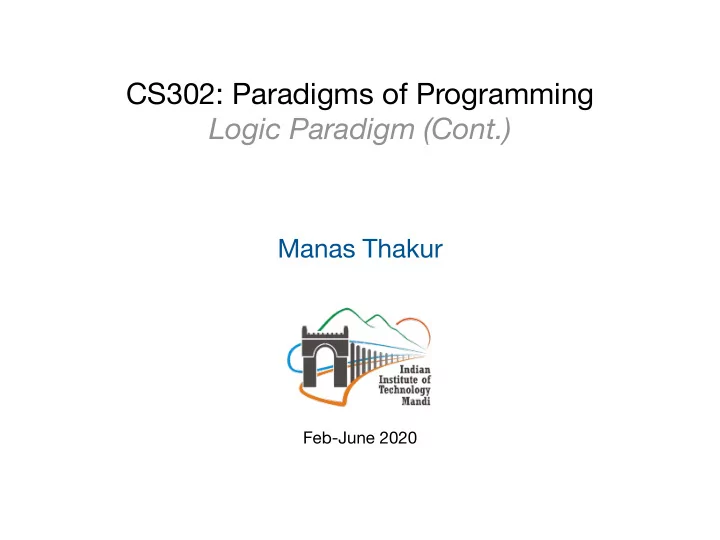

CS302: Paradigms of Programming Logic Paradigm (Cont.) Manas Thakur Feb-June 2020
From the homework • Define a sibling relationship for the Stark family: • What if you did this? • sibling(X, Y) :- parent(W, X), parent (W, Y). • Right way: • sibling(X, Y) :- parent(W, X), parent (W, Y), X \= Y. • Prolog supports relational operators. 2
How does the Prolog engine work? • Program = logic + control. • Logic is specified by user; control is managed by runtime. • Given a query: • Consult the facts and rules in top-down order. • Try to instantiate variables in the RHS of rules. • Report instantiated values that satisfy the predicates resultant from the query. 3
Resolution and Unification • Resolution. If h is the head of a Horn clause and it matches with one of the terms of another Horn clause, then than term can be replaced by h . • Unification. A pattern-matching process that determines what particular instantiations can be made to variables while making a series of simultaneous resolutions. • Which resolutions are simultaneous? • Those that satisfy the given set of predicates. • Example: ?- parent(brandon, bran). 4
Do they unify? • a & a • a & b • a & A • a & B • f(x, y) & A • f(X, b) & f(a, Y) • f(a, b) & g(a, b) • f(X, b, c) & f(a, X, c) 5
Searching and Backtracking When the path ahead is not nice, say even mice, that backtracking is wise. • Basic idea of logic paradigm: • Search through the solution space while trying to unify variables with values, till you get a solution. • If no further resolution can be done, then backtrack and try a di ff erent instantiation. • Example: ?- parent(brandon, bran). • Observe: Multiple solutions are possible. • Example: ?- grandparent(rickard, Whoall). 6
Lists • List : the basic data structure in Prolog. • [Head | Tail] • [lists, wont, leave, you, in, cs302] • Head: lists • Tail: [wont, leave, you, in, cs302] • What about [H1, H2 | T]? 7
Operations on lists • Concatenate two lists: append([], X, X). append([Head | Tail], Y, [Head | Z]) :- append(Tail, Y, Z). • Prefix: prefix(X, Z) :- append(X, Y, Z). • Su ffi x: suffix(Y, Z) :- append(X, Y, Z). • Membership: member(X, [X | _]). member(X, [_ | Y]) :- member(X, Y). • Examples on the terminal and the (virtual) white board. 8
But we had learnt numbers before lists in Scheme! • Compute the factorial of a number in Prolog: factorial(N, 1) :- N = 0. factorial(N, Result) :- N > 0, M is N - 1, factorial(M, SubRes), Result is N * SubRes. • The infix operator is forces the instantiation of a variable by performing arithmetic operations. • Is N > 0 important? • Try removing it! 9
Let’s see another example • Find the max of two numbers. max(X, Y, Y) :- X =< Y. max(X, Y, X) :- X > Y. • Observe: The interpreter waits to try more solutions, even though the cases are mutually exclusive. • What we want: Abort searching if the first case is true. • The same reasoning for the wait during grandparent(rickard, bran). 10
Recommend
More recommend